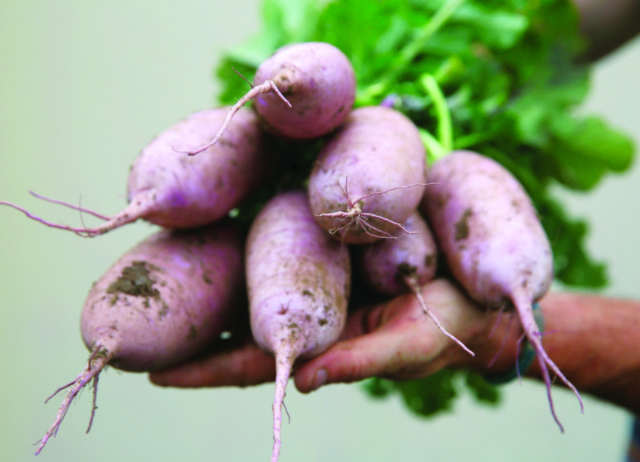
As chef/farmer Eric Skokan talks about radishes one afternoon in his Black Cat dining room, he gazes at the table before him and cups his hands around an invisible bowl.
“I can picture this chipped ceramic bowl,” Skokan says, remembering dinners of yore at his grandmother’s house in Upstate New York. “On the lazy susan at the kitchen table, there would be some bowl of salted radishes … along with a jar or pot of insanely spicy mustard and then butter that sat out 24/7, for weeks at a time, and then bread. I think of that and I get goose bumps.
“I love that sort of combination, and really the radishes are adding this really delicious background flavor to anything that they go in.”
Indeed, the radish is a veritable Swiss-Army crop. There are spring varieties (like the classic, mild, bright red cherry belles) and winter ones (like the spicy purple daikon pictured here) with myriad flavors and textures. Too, the radish serves multiple purposes on the farm and in the kitchen. In Boulder County, radish grows abundant, so we talked with Skokan and Ollin Farms’ Mark Guttridge about just what makes the radish so good.
A farmer’s dream
Out of all the radishes I grow, this is my favorite,” Guttridge says, slicing into a purple daikon.
It’s no wonder why — most radish varieties can go from seed to maturity in about a month. That makes it a valuable tool for farm finances; Guttridge says selling fast-growing radishes have helped him mitigate crop losses from this year’s hail damage.
But for regenerative farmers like Guttridge, the radish also improves soil by occupying space quickly.
“If sun’s hitting bare dirt, weeds are going to pop up,” he says. “A radish … creates a sweet little canopy. The same thing is adding a cooling effect and cooling soil.”
The benefits of soil health transfer into the radish, Guttridge says, which can break through compact soil layers to accrue phytonutrients, which concentrate in the radish’s spicy skin. The fact that radishes can stay fresh in a refrigerator all winter is just another bonus.
“To be sustainable, your beer fridge needs to have half beer, half radishes,” Guttridge says. “If everyone did that, we’d be one step closer to being a sustainable community.”
Versatile in the kitchen
Asked about how many ways he uses his Black Cat Farm-grown radishes in the kitchen, Skokan says, “I can’t count that high.”
Skokan can, however, pare down the potential uses to three categories, particularly suited for spring radishes: to provide background flavor, act as a palate cleanser, and pack a crunch.
Skokan says salting radishes for at least an hour and rinsing them will bring them a “crazy, delicious, umami flavor that you can fold into the back of other things” like soups and stews. Skokan also folds the radishes into goat cheese, chills it into a terrine and serves it with grilled bread.
For crunch, Skokan recommends shaving radishes, maybe mixing them with cucumbers, and then pairing them with soft, buttery proteins like salmon. For a palate cleanser, Skokan will substitute spicy radish in for horseradish on grilled beef.
For spicier winter radishes, Skokan says to pair them with mellow, deep, rich flavors like roasted sweet potatoes. Black Cat grates fresh radish on such dishes, and Skokan says it makes a world of difference.
“It’s something that takes in the kitchen 30 seconds to do and ends up making a dish go from, ‘Wow, that was really nice,’ to, ‘Wow, I’m a chef,’” Skokan says.














